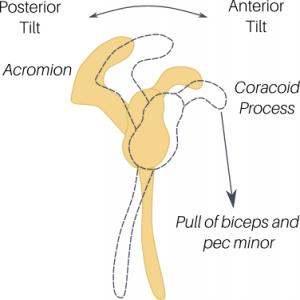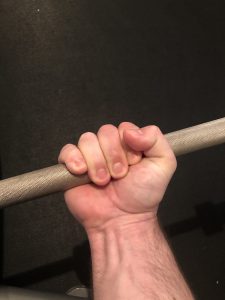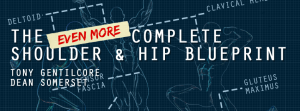3 Uncommon Tips for Improving Shoulder Mobility
While I know everyone is probably drilling the big rocks when it comes to shoulder mobility – thoracic extension, scapular upward rotation, and glenohumeral rotation – today I wanted to talk about a couple of contributing factors that often get overlooked but pay huge dividends when they get the attention they deserve in terms of producing easier and smoother overhead positions from the shoulders.
- Sternoclavicular joint motion

This joint, marked by a B in the image above, joins the collarbone or clavicle (A) with the sternal head, also known as the manubrium (F), and has some very close interconnections with the first rib (G) and it’s attachment to the manubrium (E). It’s the only bone to bone connector for the shoulder complex to the torso, and as such plays an integral part in how that region moves.
The SC joint is a saddle joint, with a convex and concave surface lining up with each other to give a ton of available motion, the same kind of joint as your thumb. So every direction of movement your thumb has, the SC joint can do it as well.
Now as with any joint in the body, abuse and misuse can cause this sucker to get stiff and tight, limiting the overall movement capability. This fibrosis can come from the joint itself, but also from the costoclavicular ligament (D) that anchors the clavicle to the first rib. If those get sticky, movement into upward rotation is going to be tricky.
A good way to see how healthy your own SC joint motion is would be to just put a finger on that joint, and then move your shoulder around. If the motion under your finger feels smooth and soft, without any weird feels or noises, the joint is likely doing fine. If there’s more popping and locking than a breakdancers convention, the joint is probably getting some mild ligamental stiffness creeping in, which could be a sign you need to keep those suckers moving as much as possible, and maybe get some targeted manual or self myofascial release through the region.
2. Scapular Tilt
We look at the rotation from the scap in terms of rotation on a flat plane of the ribs, but the truth of the matter is that the blades can rotate around the ribs and also peel off the ribs in a couple of distinct ways. We can see this in scapular winging, where the blade peels off through more of the transverse plane:

But we can also see it in a sagittal plane rotation with anterior tilt:

With seasoned lifters, anterior tilt is a pretty common thing to see as the upper traps and biceps can cause the scap to rotate forward and over the top of the ribs unless the individual has some sick lower traps and rhomboids to balance that out. Since most lifters will prefer training biceps and upper traps to smashing out some low trap raises, this imbalance is kind of a sign of a seasoned lifter. That or someone who sits at a computer all day long.
A challenge with this anterior scap tilt is that it pulls the acromion process forward and down relative to the starting position of the humerus, and effectively limits the clearance between the two compared to being in more of a posterior tilt. This anterior tilt creates an earlier point of compression between the humeral head and acromion, which limits overhead motion, plus also ups the odds of an impingement type injury to the supraspinatus tendon. Tilting the scap back opens the door, so to speak, to allow an easier range of motion of the shoulder into an overhead position with less risk of impingement injuries, plus helps balance some of the forces acting on the scap so more muscles can contribute to the motion and stability of the structure, making it stronger and easier to get yoked within your training sessions.
3. Incomplete Grip
It’s not uncommon to see someone grab a weight with a grip that looks something like this:

Whether this is a feature of grip strength, hand size relative to the bar, or wrist mobility all contribute to grabbing the bar with only 3 fingers. The downside of this is that the arm and hand are fed by 2 nerve branches from the shoulder, the ulnar nerve and the radial nerve. A 3 finger grip only utilizes the radial branch and pretty much just leaves the ulnar nerve flapping in the breeze.
Grabbing the bar with all 5 fingers, and putting some specific intent behind getting that pinkie finger onto the bar, can help increase neural drive from the ulnar nerve, which can help give some serious irradiative effect to the shoulder muscles and help produce a higher activity of the rotator cuff muscles, assisting in centering the humeral head in the cup.

These 3 simple and often overlooked factors that contribute to shoulder mobility are just some of the things we cover in “Even More Complete Shoulder & Hip Blueprint,” a video series featuring Tony Gentilcore and myself, where we dive deep into all factors that affect shoulder mobility and strength, as well as program design considerations to get the most from your workouts, regardless of your goals and limitations.

Here’s a short snippet of some of the info we cover.
Here’s a sample of some concepts we dig into.
Shoulder:
- How to use the static and integrative assessments to guide your training program.
- How breathing mechanics drives mobility of the upper body and stability of the lower body, and how to use it to see fast improvements in both.
- neck positioning, sternoclavicular joint, and elbow considerations with shoulder movements
- Deeper assessment considerations, including medical elements that may require a referral for non-fitness modalities
- Why “impingement” and “scapular winging” are garbage terms, how to assess for their true function and purpose, the difference between internal and external impingement, and what it means to your training program
- How simplifying your upper extremity assessment to the “Big 3” – Release, Position, Mobilize – can and will cover your bases for most shoulder ailments.
- Heavy pressing, explosive throwing, and programming considerations for different goal sets and populations
Why this matters to you:
- Help your clients get through common shoulder issues more effectively.
- Streamline your assessment and program design, helping you get faster results and more efficient use of your time, and that of your clients’
- Help you see the details of shoulder motion you didn’t notice before, and whether something you’re using in your exercise program is working or not. Plus look at whether neck or clavicular issues may be impeding their strength and mobility.
- Upgrade your exercise toolbox to address commonly overlooked movement issues
- Smash programming like a Jedi
Hip:
- The hips role in low back, SI joint, and knee issues commonly seen in the gym, and how to address them from a fitness perspective
- Static versus active mobility, how and when to use each, and what produces the best benefits
- Scaling compound lifts across populations and goals, and how to effectively program them for everyone
- Jumps, sprints, change of direction, and other explosive training elements, and how they relate to the individuals goals and abilities.
- Blending strength, mobility and recovery across age ranges, and how to avoid being a beat up meathead or chronic recoverer
- spinal motion intolerances, and how to program around common issues.
What this means to you:
- You can help clients see IMMEDIATE improvements, sometimes in as little as a minute or two, which will help them buy in to your abilities.
- Help you target in on what will work best for the person in front of you, saving you both the time spent on useless exercises or drills.
- Help clients get specific with what will help them get stronger, more mobile, and faster than ever before
- Break down a system you can use today with yourself or your clients to see instant benefit while removing the guess work.
This series can be used for continuing education credits, with 1.2 units or 12 contact hours granted through the NSCA.
There’s even a combo pack option, with our “level 1” workshop content in addition to this “level 2” content. The level 1 content is all of the foundational work we discuss in terms of anatomy, assessments, and corrective options plus training regressions we use to get people into optimal positions to build strength with the training we work through in the level 2.
Now because we know financial situations are tight right now for many, we’ve also offered a 4 month financing option for no additional charge for both the level 2 seminar as well as the combo pack. These packs both come with a 30 day unconditional money back guarantee as well.
We have the series on sale until the end of the day today, so act quick to save some big bucks, plus get in on the financing option if needed.